display Mercury Villager 2000 Owner's Manuals
[x] Cancel search | Manufacturer: MERCURY, Model Year: 2000, Model line: Villager, Model: Mercury Villager 2000Pages: 256, PDF Size: 2.21 MB
Page 15 of 256
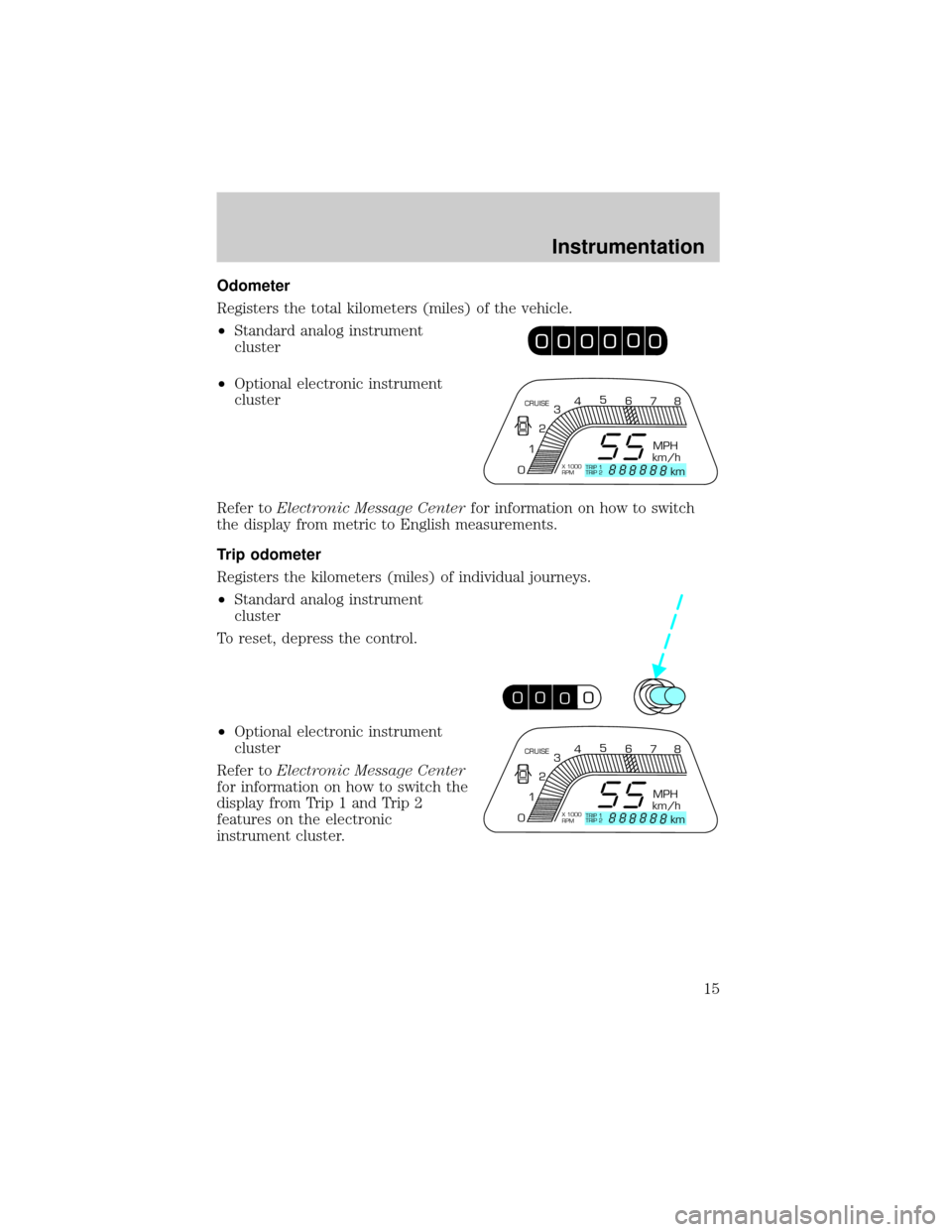
Odometer
Registers the total kilometers (miles) of the vehicle.
²Standard analog instrument
cluster
²Optional electronic instrument
cluster
Refer toElectronic Message Centerfor information on how to switch
the display from metric to English measurements.
Trip odometer
Registers the kilometers (miles) of individual journeys.
²Standard analog instrument
cluster
To reset, depress the control.
²Optional electronic instrument
cluster
Refer toElectronic Message Center
for information on how to switch the
display from Trip 1 and Trip 2
features on the electronic
instrument cluster.
0
00
00
000
000
0
CRUISE
MPH
km/h
km 012345
6
78
X 1000
RPMTRIP 1
TRIP 2
00
0000
00
CRUISE
MPH
km/h
km 012345
6
78
X 1000
RPMTRIP 1
TRIP 2
Instrumentation
15
Page 16 of 256
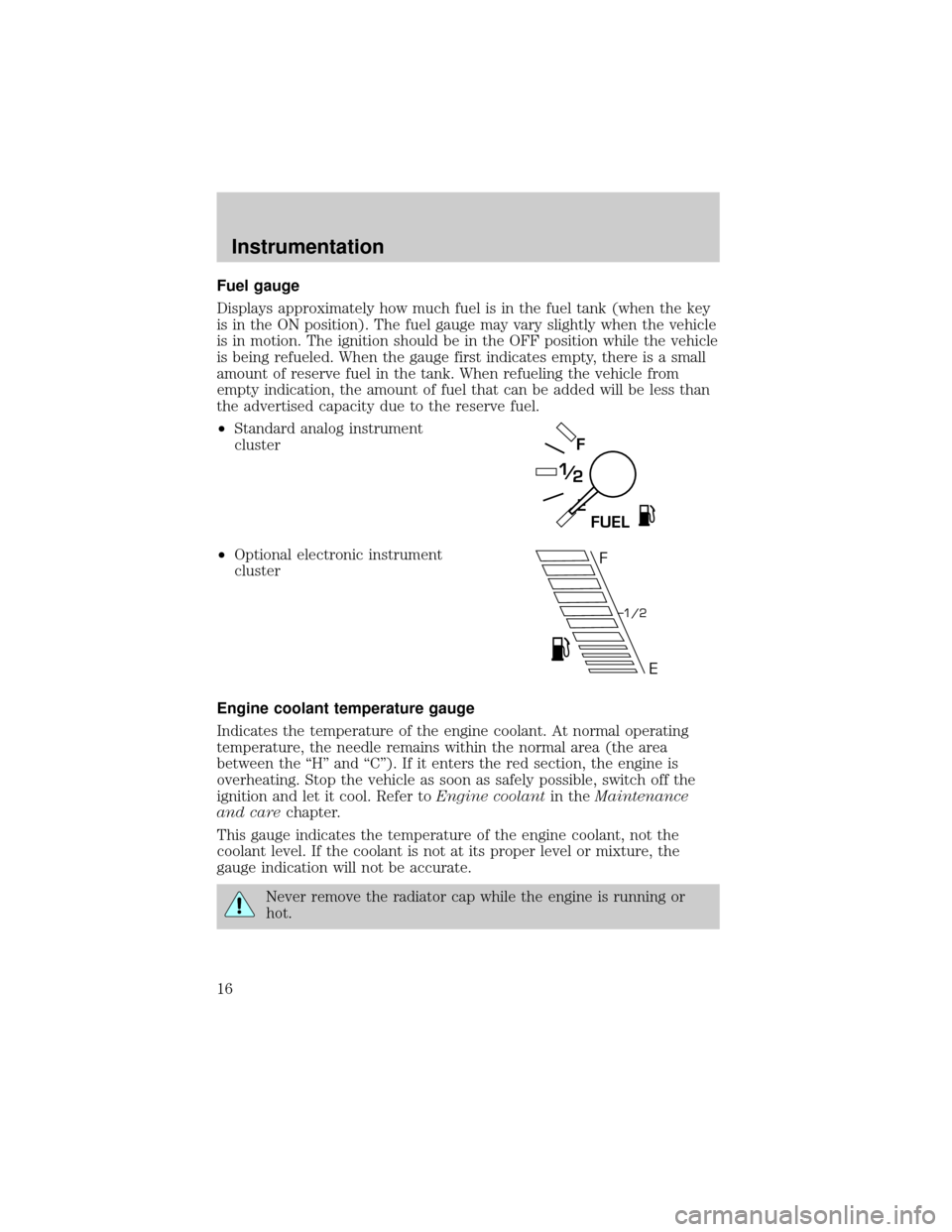
Fuel gauge
Displays approximately how much fuel is in the fuel tank (when the key
is in the ON position). The fuel gauge may vary slightly when the vehicle
is in motion. The ignition should be in the OFF position while the vehicle
is being refueled. When the gauge first indicates empty, there is a small
amount of reserve fuel in the tank. When refueling the vehicle from
empty indication, the amount of fuel that can be added will be less than
the advertised capacity due to the reserve fuel.
²Standard analog instrument
cluster
²Optional electronic instrument
cluster
Engine coolant temperature gauge
Indicates the temperature of the engine coolant. At normal operating
temperature, the needle remains within the normal area (the area
between the ªHº and ªCº). If it enters the red section, the engine is
overheating. Stop the vehicle as soon as safely possible, switch off the
ignition and let it cool. Refer toEngine coolantin theMaintenance
and carechapter.
This gauge indicates the temperature of the engine coolant, not the
coolant level. If the coolant is not at its proper level or mixture, the
gauge indication will not be accurate.
Never remove the radiator cap while the engine is running or
hot.
E
F
FUEL
F
E
1/2
Instrumentation
16
Page 17 of 256
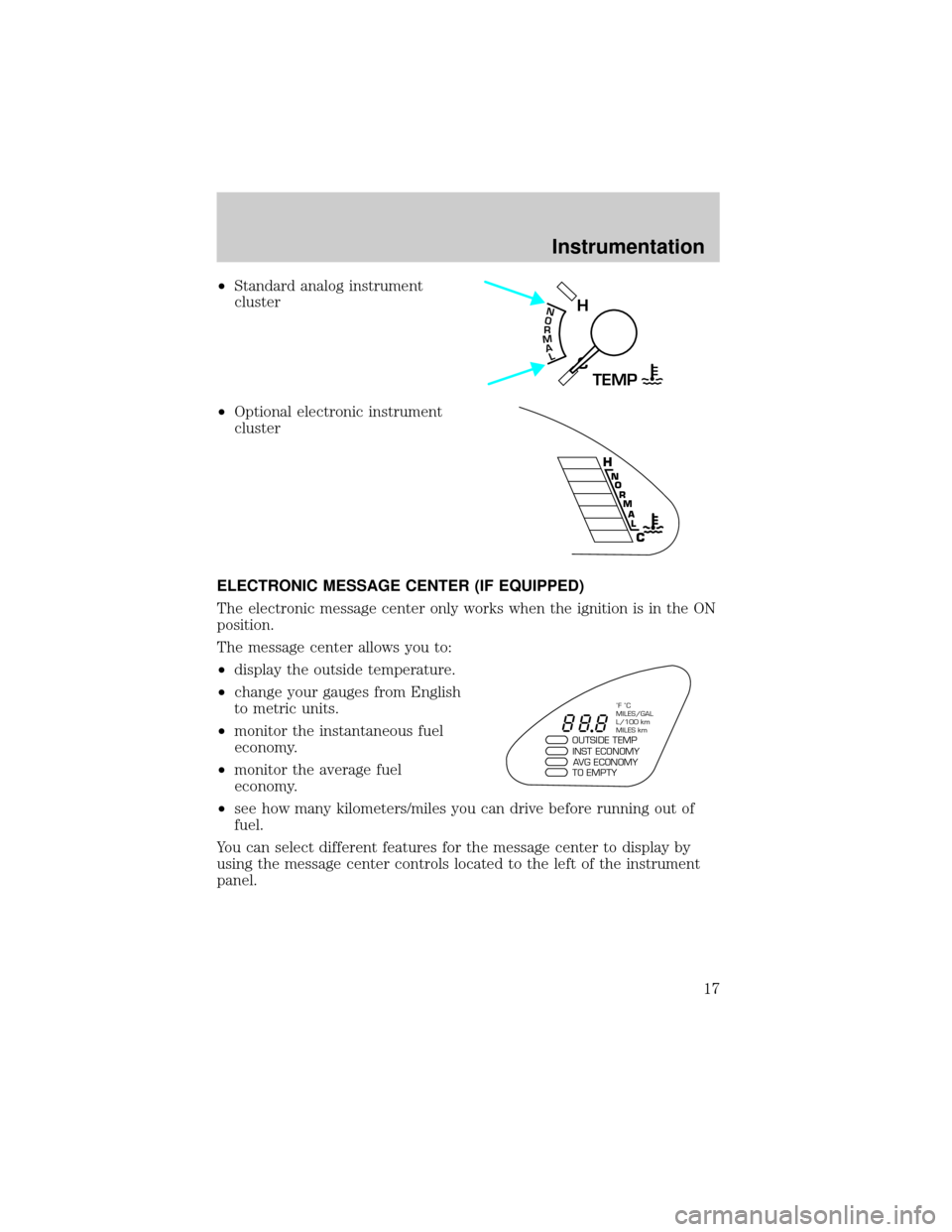
²Standard analog instrument
cluster
²Optional electronic instrument
cluster
ELECTRONIC MESSAGE CENTER (IF EQUIPPED)
The electronic message center only works when the ignition is in the ON
position.
The message center allows you to:
²display the outside temperature.
²change your gauges from English
to metric units.
²monitor the instantaneous fuel
economy.
²monitor the average fuel
economy.
²see how many kilometers/miles you can drive before running out of
fuel.
You can select different features for the message center to display by
using the message center controls located to the left of the instrument
panel.
C
H
TEMPNORMAL
H
CN
O
R
M
A
L
OUTSIDE TEMPINST ECONOMY
AVG ECONOMY
TO EMPTY
˚F ˚C
MILES/GAL
L/100 km
MILES km
Instrumentation
17
Page 18 of 256
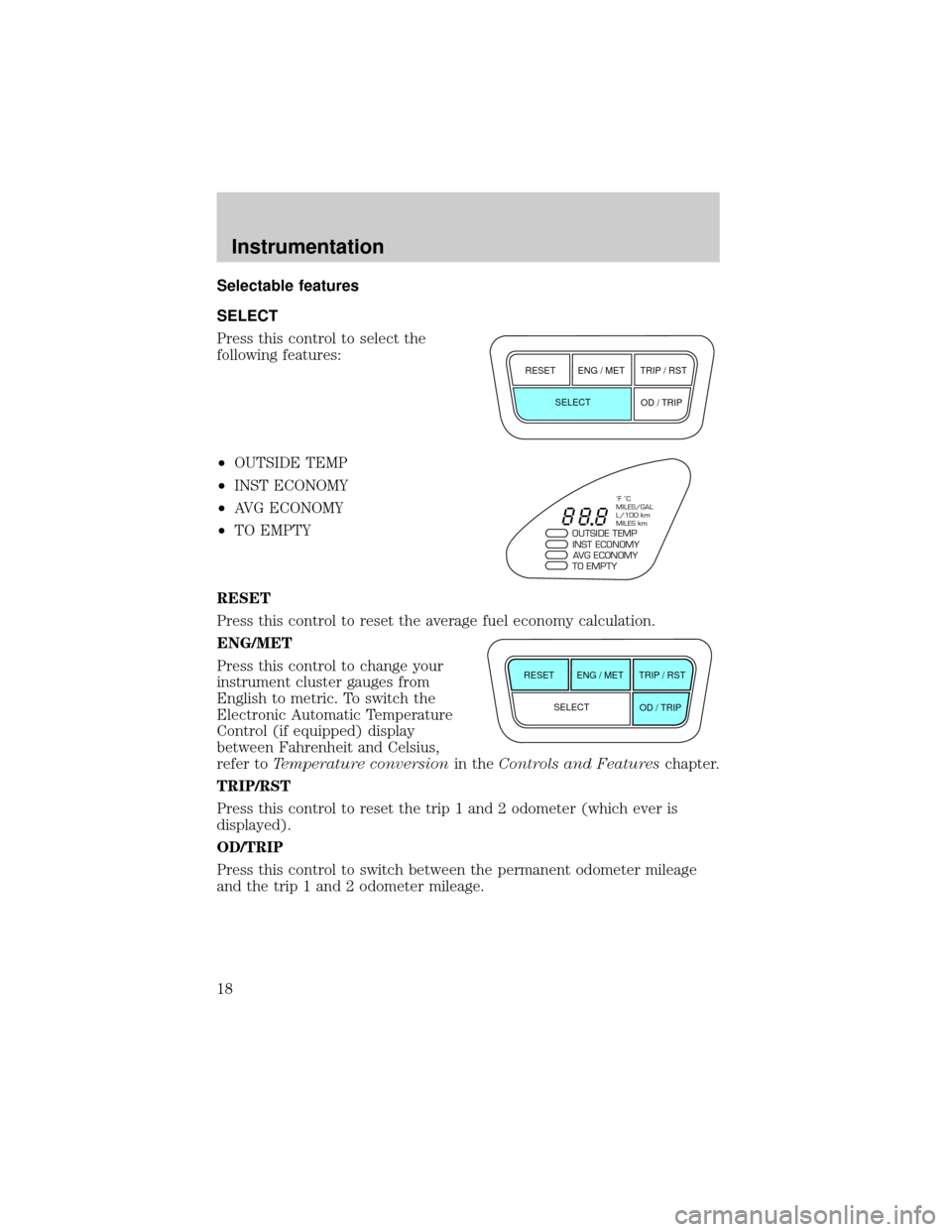
Selectable features
SELECT
Press this control to select the
following features:
²OUTSIDE TEMP
²INST ECONOMY
²AVG ECONOMY
²TO EMPTY
RESET
Press this control to reset the average fuel economy calculation.
ENG/MET
Press this control to change your
instrument cluster gauges from
English to metric. To switch the
Electronic Automatic Temperature
Control (if equipped) display
between Fahrenheit and Celsius,
refer toTemperature conversionin theControls and Featureschapter.
TRIP/RST
Press this control to reset the trip 1 and 2 odometer (which ever is
displayed).
OD/TRIP
Press this control to switch between the permanent odometer mileage
and the trip 1 and 2 odometer mileage.
SELECT
OD / TRIP RESET ENG / MET TRIP / RST
OUTSIDE TEMPINST ECONOMY
AVG ECONOMY
TO EMPTY
˚F ˚C
MILES/GAL
L/100 km
MILES km
SELECT
OD / TRIP RESET ENG / MET TRIP / RST
Instrumentation
18
Page 19 of 256
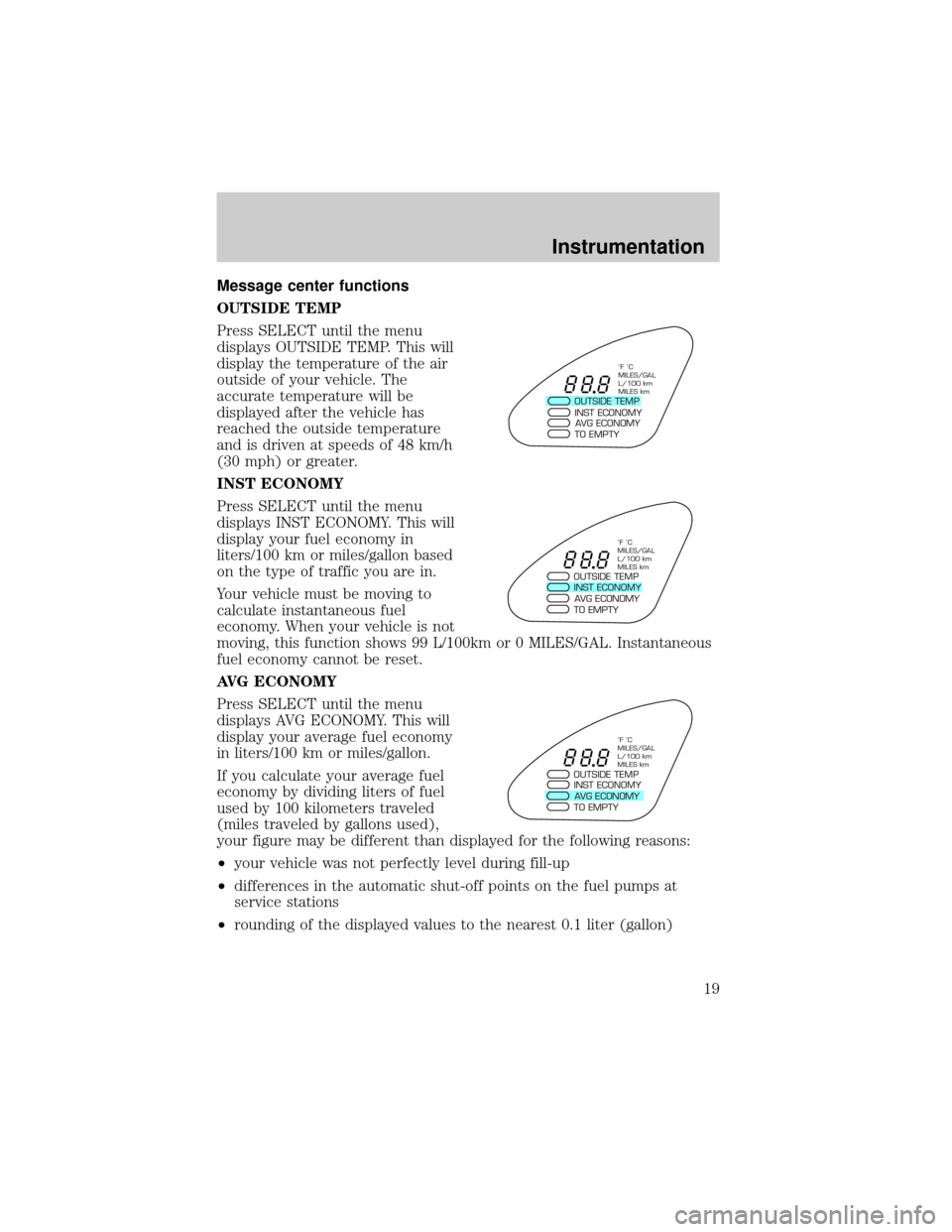
Message center functions
OUTSIDE TEMP
Press SELECT until the menu
displays OUTSIDE TEMP. This will
display the temperature of the air
outside of your vehicle. The
accurate temperature will be
displayed after the vehicle has
reached the outside temperature
and is driven at speeds of 48 km/h
(30 mph) or greater.
INST ECONOMY
Press SELECT until the menu
displays INST ECONOMY. This will
display your fuel economy in
liters/100 km or miles/gallon based
on the type of traffic you are in.
Your vehicle must be moving to
calculate instantaneous fuel
economy. When your vehicle is not
moving, this function shows 99 L/100km or 0 MILES/GAL. Instantaneous
fuel economy cannot be reset.
AVG ECONOMY
Press SELECT until the menu
displays AVG ECONOMY. This will
display your average fuel economy
in liters/100 km or miles/gallon.
If you calculate your average fuel
economy by dividing liters of fuel
used by 100 kilometers traveled
(miles traveled by gallons used),
your figure may be different than displayed for the following reasons:
²your vehicle was not perfectly level during fill-up
²differences in the automatic shut-off points on the fuel pumps at
service stations
²rounding of the displayed values to the nearest 0.1 liter (gallon)
OUTSIDE TEMPINST ECONOMY
AVG ECONOMY
TO EMPTY
˚F ˚C
MILES/GAL
L/100 km
MILES km
OUTSIDE TEMPINST ECONOMY
AVG ECONOMY
TO EMPTY
˚F ˚C
MILES/GAL
L/100 km
MILES km
OUTSIDE TEMPINST ECONOMY
AVG ECONOMY
TO EMPTY
˚F ˚C
MILES/GAL
L/100 km
MILES km
Instrumentation
19
Page 20 of 256
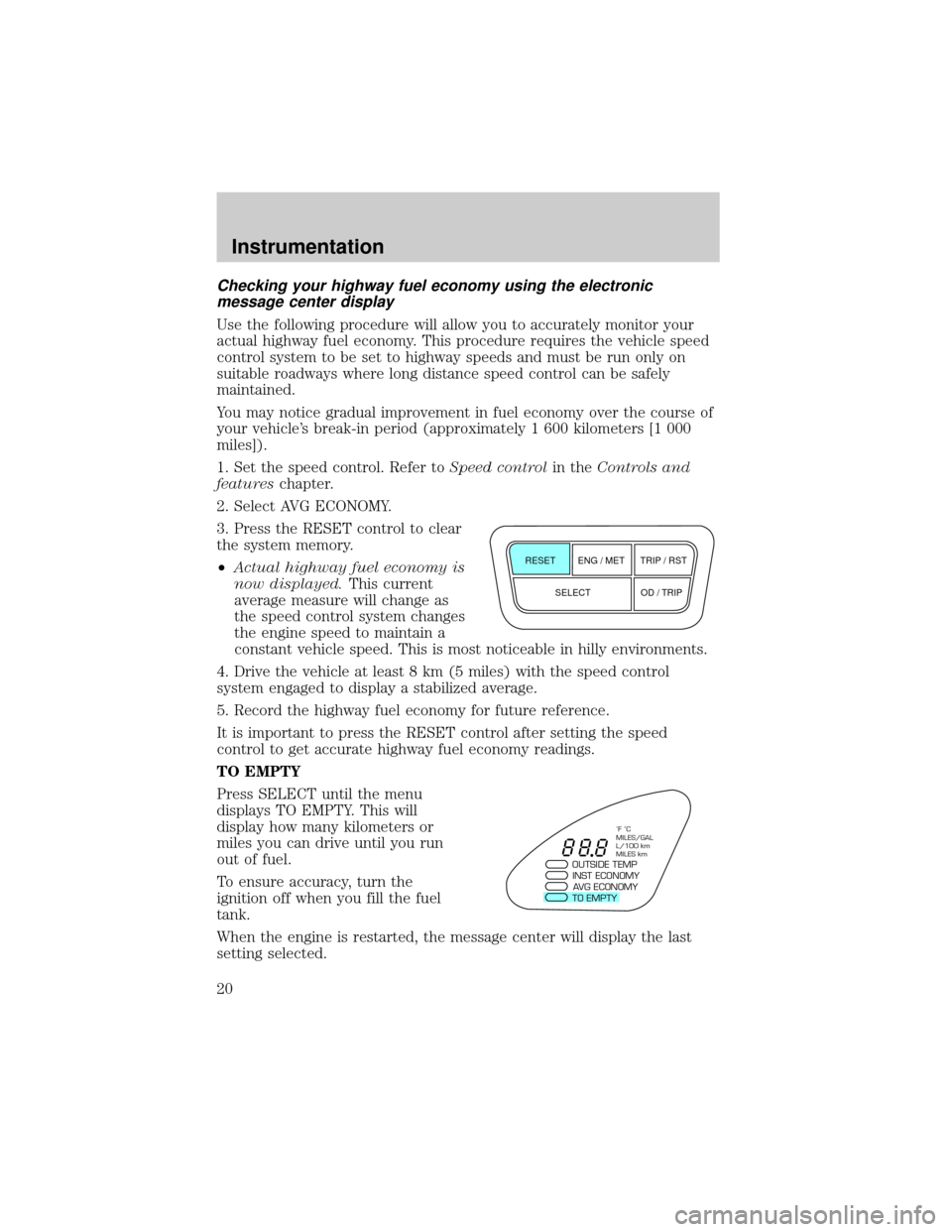
Checking your highway fuel economy using the electronic
message center display
Use the following procedure will allow you to accurately monitor your
actual highway fuel economy. This procedure requires the vehicle speed
control system to be set to highway speeds and must be run only on
suitable roadways where long distance speed control can be safely
maintained.
You may notice gradual improvement in fuel economy over the course of
your vehicle's break-in period (approximately 1 600 kilometers [1 000
miles]).
1. Set the speed control. Refer toSpeed controlin theControls and
featureschapter.
2. Select AVG ECONOMY.
3. Press the RESET control to clear
the system memory.
²Actual highway fuel economy is
now displayed.This current
average measure will change as
the speed control system changes
the engine speed to maintain a
constant vehicle speed. This is most noticeable in hilly environments.
4. Drive the vehicle at least 8 km (5 miles) with the speed control
system engaged to display a stabilized average.
5. Record the highway fuel economy for future reference.
It is important to press the RESET control after setting the speed
control to get accurate highway fuel economy readings.
TO EMPTY
Press SELECT until the menu
displays TO EMPTY. This will
display how many kilometers or
miles you can drive until you run
out of fuel.
To ensure accuracy, turn the
ignition off when you fill the fuel
tank.
When the engine is restarted, the message center will display the last
setting selected.
SELECT
OD / TRIP RESET ENG / MET TRIP / RST
OUTSIDE TEMPINST ECONOMY
AVG ECONOMY
TO EMPTY
˚F ˚C
MILES/GAL
L/100 km
MILES km
Instrumentation
20
Page 30 of 256
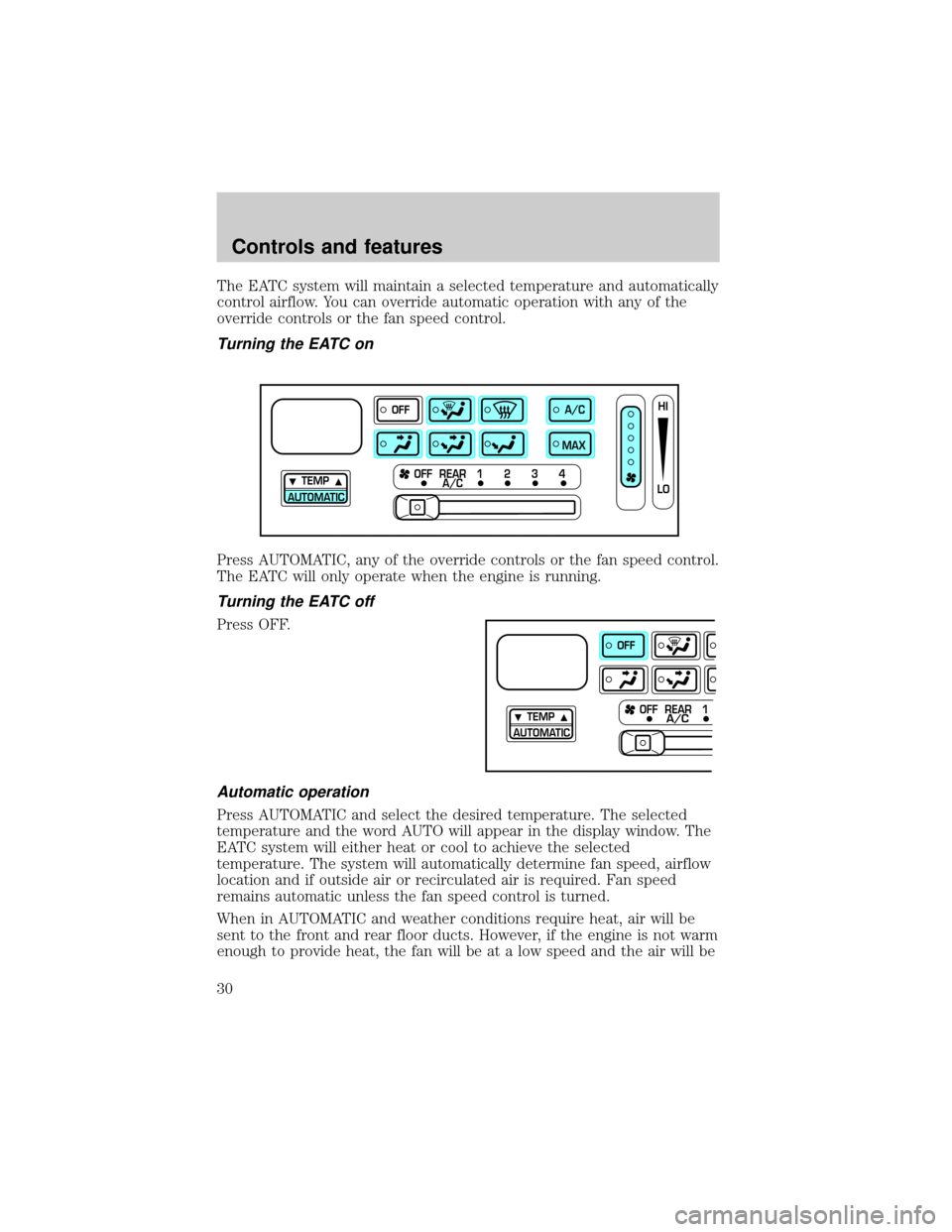
The EATC system will maintain a selected temperature and automatically
control airflow. You can override automatic operation with any of the
override controls or the fan speed control.
Turning the EATC on
Press AUTOMATIC, any of the override controls or the fan speed control.
The EATC will only operate when the engine is running.
Turning the EATC off
Press OFF.
Automatic operation
Press AUTOMATIC and select the desired temperature. The selected
temperature and the word AUTO will appear in the display window. The
EATC system will either heat or cool to achieve the selected
temperature. The system will automatically determine fan speed, airflow
location and if outside air or recirculated air is required. Fan speed
remains automatic unless the fan speed control is turned.
When in AUTOMATIC and weather conditions require heat, air will be
sent to the front and rear floor ducts. However, if the engine is not warm
enough to provide heat, the fan will be at a low speed and the air will be
TEMP
AUTOMATICOFF REAR 1 2 3 4
OFFA/C
A/CMAXHI
LO
TEMP
AUTOMATICOFF REAR 1
OFF
A/C
Controls and features
30
Page 31 of 256
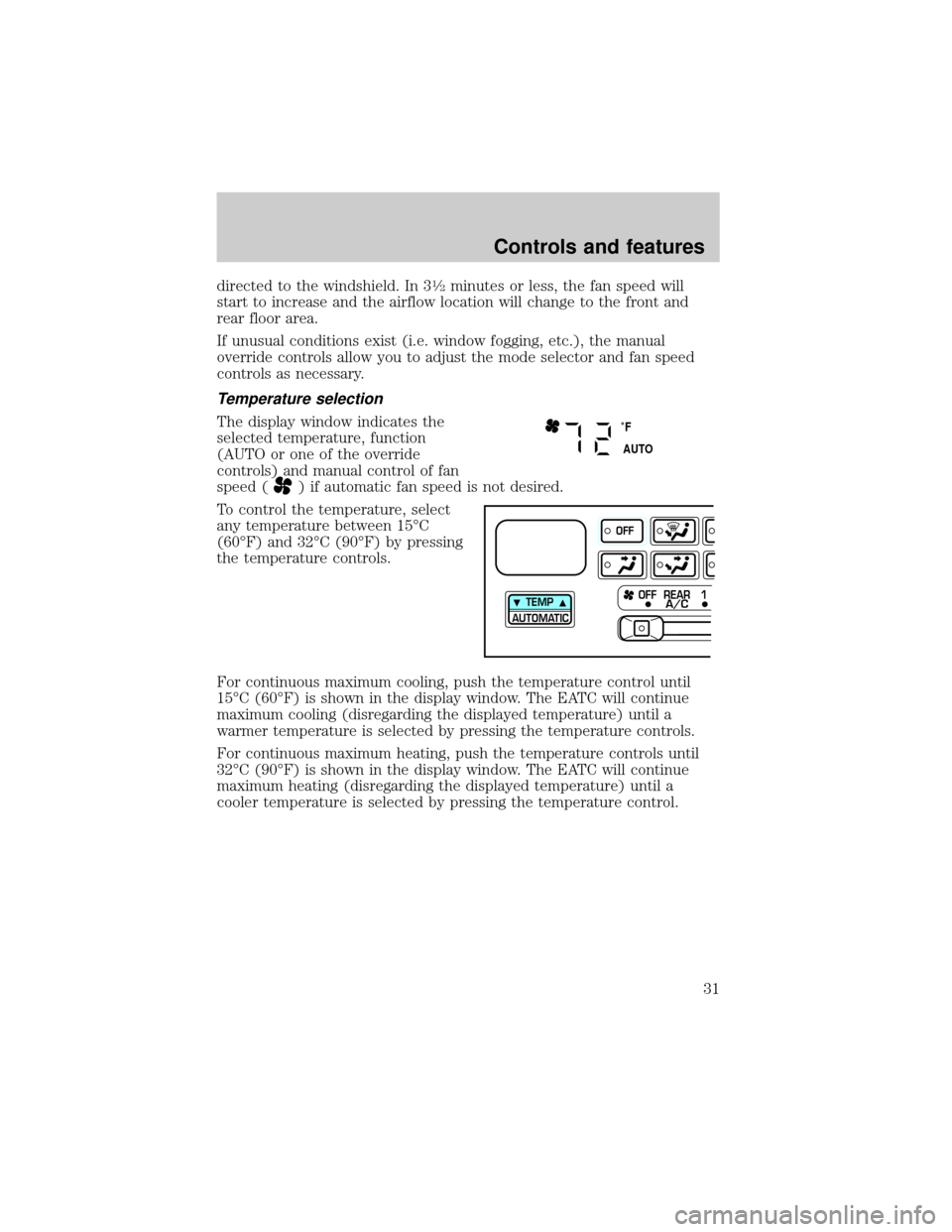
directed to the windshield. In 31¤2minutes or less, the fan speed will
start to increase and the airflow location will change to the front and
rear floor area.
If unusual conditions exist (i.e. window fogging, etc.), the manual
override controls allow you to adjust the mode selector and fan speed
controls as necessary.
Temperature selection
The display window indicates the
selected temperature, function
(AUTO or one of the override
controls) and manual control of fan
speed (
) if automatic fan speed is not desired.
To control the temperature, select
any temperature between 15ÉC
(60ÉF) and 32ÉC (90ÉF) by pressing
the temperature controls.
For continuous maximum cooling, push the temperature control until
15ÉC (60ÉF) is shown in the display window. The EATC will continue
maximum cooling (disregarding the displayed temperature) until a
warmer temperature is selected by pressing the temperature controls.
For continuous maximum heating, push the temperature controls until
32ÉC (90ÉF) is shown in the display window. The EATC will continue
maximum heating (disregarding the displayed temperature) until a
cooler temperature is selected by pressing the temperature control.
˚F
AUTO
TEMP
AUTOMATICOFF REAR 1
OFF
A/C
Controls and features
31
Page 32 of 256
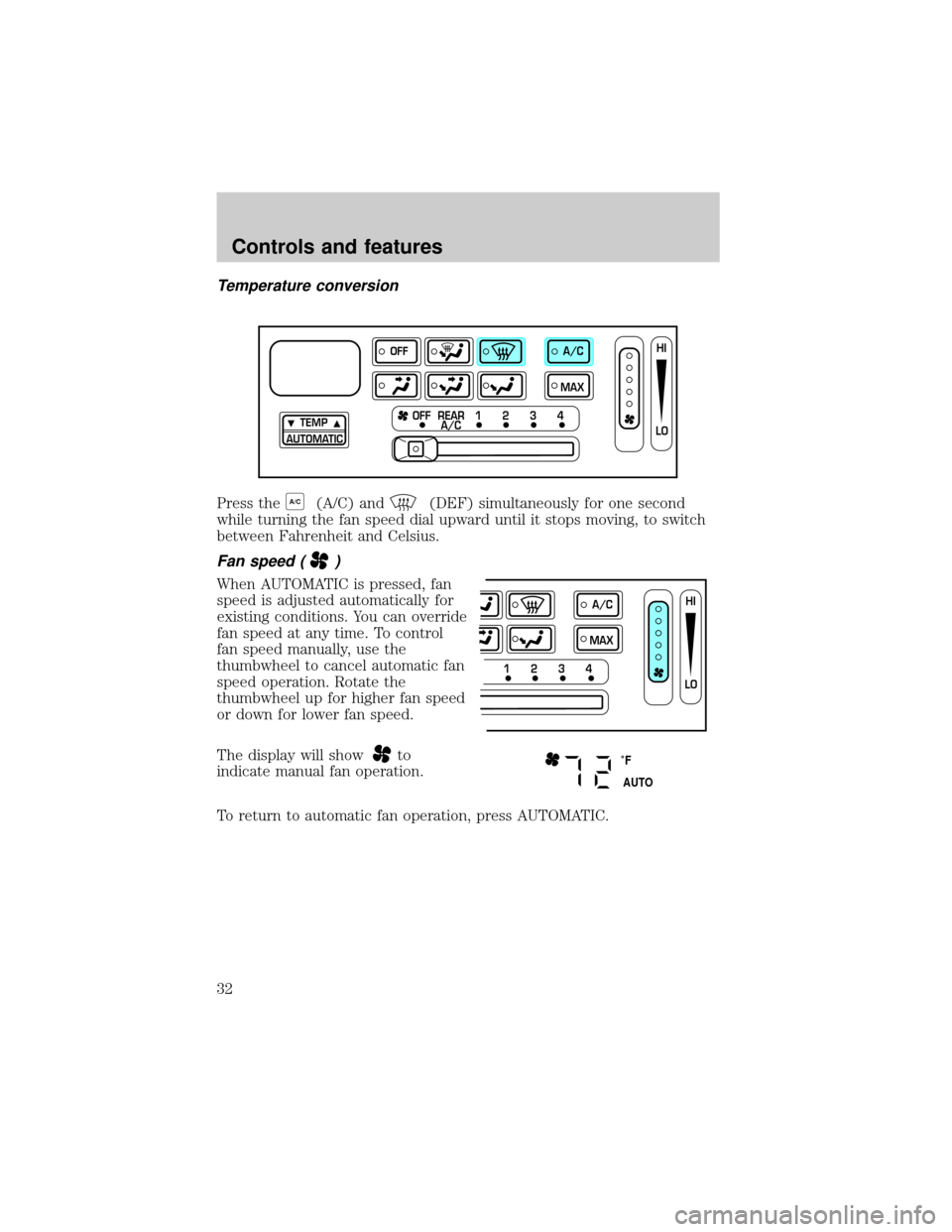
Temperature conversion
Press theA/C(A/C) and(DEF) simultaneously for one second
while turning the fan speed dial upward until it stops moving, to switch
between Fahrenheit and Celsius.
Fan speed ()
When AUTOMATIC is pressed, fan
speed is adjusted automatically for
existing conditions. You can override
fan speed at any time. To control
fan speed manually, use the
thumbwheel to cancel automatic fan
speed operation. Rotate the
thumbwheel up for higher fan speed
or down for lower fan speed.
The display will show
to
indicate manual fan operation.
To return to automatic fan operation, press AUTOMATIC.
TEMP
AUTOMATICOFF REAR 1 2 3 4
OFFA/C
A/CMAXHI
LO
1 2 3 4A/C
MAXHI
LO
˚F
AUTO
Controls and features
32
Page 45 of 256
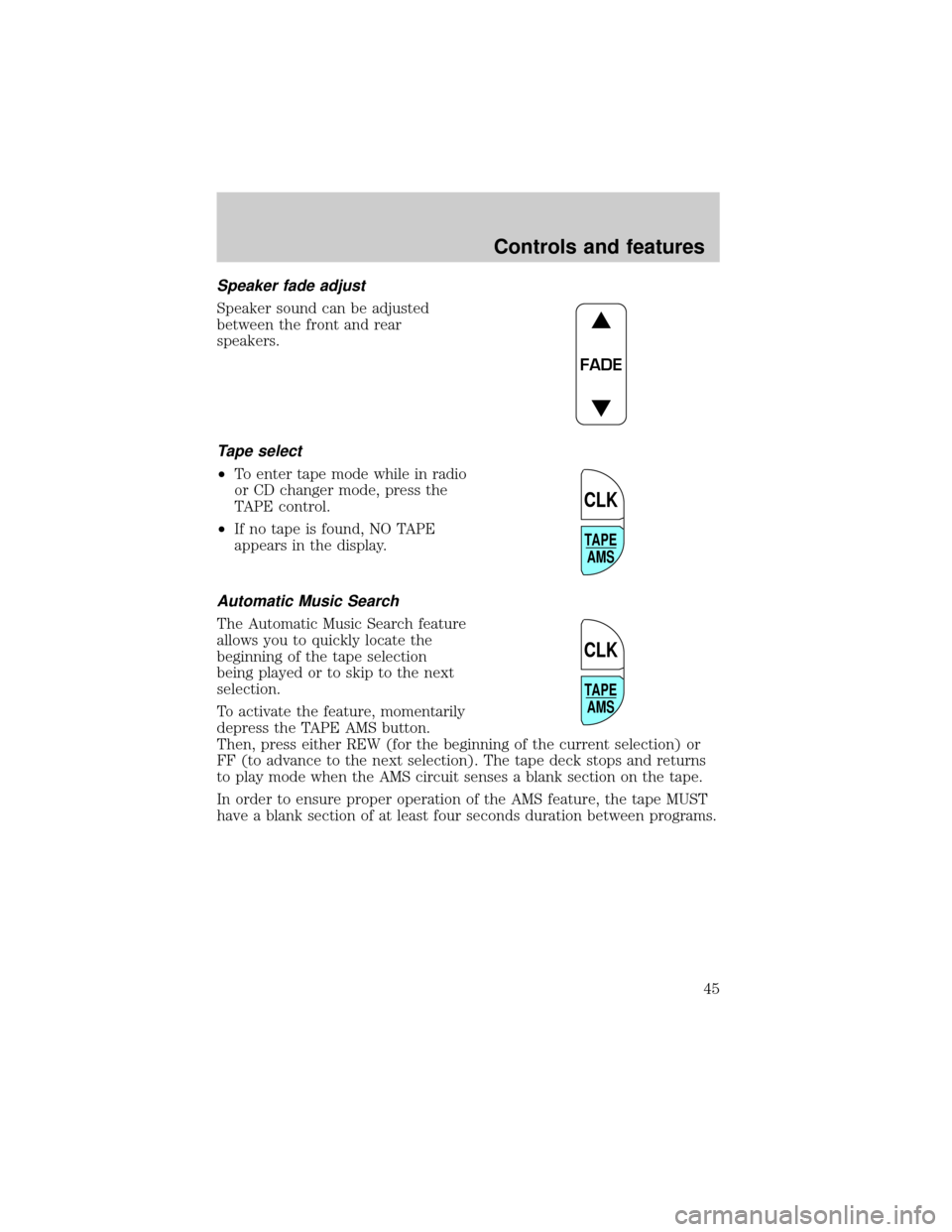
Speaker fade adjust
Speaker sound can be adjusted
between the front and rear
speakers.
Tape select
²To enter tape mode while in radio
or CD changer mode, press the
TAPE control.
²If no tape is found, NO TAPE
appears in the display.
Automatic Music Search
The Automatic Music Search feature
allows you to quickly locate the
beginning of the tape selection
being played or to skip to the next
selection.
To activate the feature, momentarily
depress the TAPE AMS button.
Then, press either REW (for the beginning of the current selection) or
FF (to advance to the next selection). The tape deck stops and returns
to play mode when the AMS circuit senses a blank section on the tape.
In order to ensure proper operation of the AMS feature, the tape MUST
have a blank section of at least four seconds duration between programs.
FADE
TAPE
AMS
CLK
TAPE
AMS
CLK
Controls and features
45